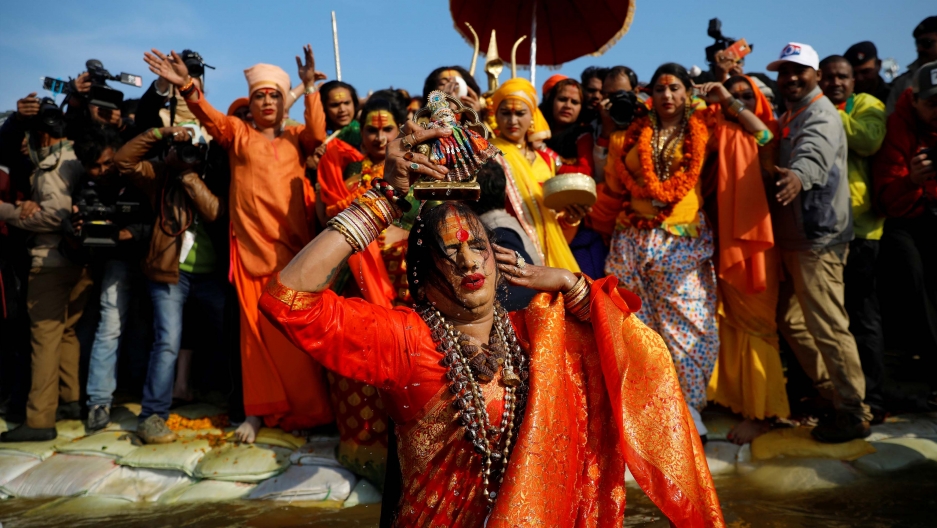Hijras occupy a powerful yet precarious position in modern Pakistani and Indian society. The term “hijra,” literally meaning “eunuch” in Urdu (though self-castration is not as common of a practice today), is often replaced with the word “intersex” and “transgender” in discussions by Western social scientists that does not portray the full picture.

Hijras, most frequently male by birth, occupy a significant cultural and religious status in the Hindu culture. Hijras are most frequently chosen to associate themselves with Ardhanarisvara (a form of Shiva, the third god in the Hindu triumvirates. The Hindu triumvirate refers to the three main gods who provide the universe with creation (Brahma), preservation (Vishnu), and destruction (Shiva)- so this association is a big deal), and Bahuchara Mata (the divine deity of fertility and transgenderism).
Throughout Hindu texts and mythology, they appear alongside figures like Arjuna (who lives for a year as a eunuch in the epic, the Mahabharata ), Lord Rama, and Krishna associated with sexual ambivalence. In one of these stories, a group of hijras waited for 14 years for a religious figure (Lord Rama) who was held in exile. For their loyalty, hijras were gifted with the ability to provide holy blessings at major life events like childbirth and weddings. Additionally, hijras may also refer to themselves as Kinnar in parts of Northern India. The term Kinnar emphasizes their association with art, dance, music, and ritual as all of these activities are seen as an embodiment of Shiva and the duality of masculinity and feminity.

Before British colonial rule, they held a great deal of power in the region, acting in important administrative positions. During British rule, they were labeled as criminals as neither male nor female caused the British to label them as perverse and breaking laws about homosexuality. Outside of religious spheres, they were stripped of their power. In the modern-day, most hijras are disowned by their families and turn to prostitution and begging to sustain themselves. The religious significance of their association with sexuality has forced many of these people to become sex workers as their only available profession. So while some hijras are employed to dance at temples, perform music, and bless newborn children, people also accuse hijra of sexual perversion and polluting cultural values.
Until a landmark ruling in 2014, hijras were not equally protected under the law. Until they gained the legal status of being a part of the Other Backward Class (OBC), they could not identify themselves as the third gender on any official documents. As such, it was legal for them to be discriminated against for employment and education. On another note, other members of the LGBTQIA+ community are not protected under this ruling, including other transgender people- this legal protection only extends to hijra who has religious associations. Furthermore, while there is legal protection for hijras, many hijras still face insurmountable political barriers. While hijra was given the ability to vote and have voter registration cards, many face harassment when they try to vote or work because their identifications depict them without markers of their gender expression. Traditionally, hijras wear bright and colorful saris, gold jewelry, and heavy makeup. They often face harassment when they present femininely and are depicted as males presenting in their ID cards.

All of this occurs in addition to the pressures that hijra fact within their own community itself. Hijra has a very secretive and hierarchical community. Like house mothers in the American LGBTIA+ ball and drag community, gurus protect the younger chelas in their community. A guru’s role is a mix between adoptive mother, pimp, mentor, and spiritual leader. Their job is to teach their disciples how to survive and protect themselves, along with religious rituals and the roles that hijra plays in society. Since there is a lot of police corruption in India and Pakistan, many gurus will also “pay off” community members or police officers to persecute abusive customers or incentivize the police to ‘look away” for their practices.
So while the societal position of hijras has improved since British colonial rule, a lot of progress still has to be made. Recent technologies have made sex changes more easily accessible to the hijra community but, they still face a heinous amount of violence and discrimination for their gender identity. They are noticeably absent from adequate political representation and are still relegated to beggars and untouchables. More by the Indian government needs to be done, but the larger Indian and Pakistani society’s mindset needs to change even more urgently.
Source
- https://www.astroved.com/astropedia/en/goddess/bahuchara-devi
- https://whatishinduism.weebly.com/important-figures.html#:~:text=The%20Hindu%20triumvirate%20(a%20group,and%20destruction%20of%20the%20universe.
- https://www.everyculture.com/South-Asia/Hijra-Religion-and-Expressive-Culture.html
- https://myvoice.opindia.com/2020/06/indias-third-gender-a-journey-of-hijra-community-from-mythology-to-harsh-reality/
- https://www.nytimes.com/2018/02/17/style/india-third-gender-hijras-transgender.html
- https://timesofindia.indiatimes.com/india/OBC-quota-for-transgenders-wont-cover-gays-lesbians-SC/articleshow/52998660.cms

